The Potential of Absorbing Foreign Agricultural Investment to Improve Food Security in Developing Countries
Abstract
1. Introduction
2. Theories and Methodology
2.1. Theories of FDI
2.2. Methodology and Data
2.2.1. Indicators for Measuring Investment Demand
2.2.2. Indicators for Measuring Investment Motivation
2.2.3. Indicators for Measuring Investment Environment
2.2.4. Methodology
Principal Component Analysis
Spearman Correlation Analysis
3. Results
3.1. Single Dimension Feature
3.1.1. Investment Demand
3.1.2. Investment Environment
3.1.3. Investment Attractiveness
3.2. Correlation Analysis
3.2.1. Investment Demand and Investment Environment
3.2.2. Investment Demand and Investment Attractiveness
3.2.3. Investment Environment and Investment Attractiveness
4. Discussion and Policy Implications
4.1. Discussion
4.2. Policy Implications
5. Conclusions
Author Contributions
Funding
Acknowledgments
Conflicts of Interest
References
- Pérez-Escamilla, R.; Shamah-Levy, T.; Candel, J. Food security governance in Latin America: Principles and the way forward. Glob. Food Secur. 2017, 14, 68–72. [Google Scholar] [CrossRef]
- Food and Agriculture Organization. The Food Security and Nutrition in the World. Safeguarding Against Economic Slowdowns and Downturns. 2019. Available online: http://120.221.32.86:6510/www.fao.org/3/ca5162en/ca5162en.pdf (accessed on 13 March 2020).
- Barrett, C.B.; Palm, C. Meeting the global food security challenge: Obstacles and opportunities ahead. Glob. Food Secur. 2016, 11, 1–4. [Google Scholar] [CrossRef]
- Gonzalez, R.B. Impacts of Climate Change on Crop Production in Bolivia and Peru: A Systematic Review of Evidence. Outlook Agric. 2015, 44, 143–149. [Google Scholar] [CrossRef]
- Hertel, T.W.; Baldos, U.L.C. Attaining food and environmental security in an era of globalization. Glob. Environ. Chang. 2016, 41, 195–205. [Google Scholar] [CrossRef]
- Thornton, P.; Dinesh, D.; Cramer, L.; Loboguerrero, A.M.; Campbell, B. Agriculture in a changing climate: Keeping our cool in the face of the hothouse. Outlook Agric. 2018, 47, 283–290. [Google Scholar] [CrossRef]
- Fan, S.; Brzeska, J. Feeding more people on an increasingly fragile planet: China’s food and nutrition security in a national and global context. J. Integr. Agric. 2014, 13, 1193–1205. [Google Scholar] [CrossRef]
- World Development Report 2008: Agriculture for Development. Available online: https://elibrary.worldbank.org/doi/pdf/10.1596/978-0-8213-7297-5 (accessed on 2 July 2019).
- Morea, D.; Balzarini, M. Financial sustainability of a public-private partnership for an agricultural development project in Sub-Saharan Africa. Agric. Econ. 2018, 64, 389–398. [Google Scholar]
- Trends in Foreign Direct Investment in the Agricultural Sector of Developing and Transition Countries: A Review. Available online: http://www.gffa-berlin.de/images/stories/GFFA2013/studie%20der%20universitt%20wien.pdf (accessed on 2 July 2019).
- Anríquez, G.; Foster, W.; Ortega, J. Rural and agricultural subsidies in Latin America: Development costs of misallocated public resources. Dev. Policy Rev. 2020, 38, 140–158. [Google Scholar] [CrossRef]
- Hallam, D. Foreign Investment in Developing Country Agriculture—Issues, Policy Implications and International Response. Beyond the crisis: International investment for a stronger, cleaner, fairer global economy. In Proceedings of the OECD 8th Global Forum on International Investment VIII, Paris, France, 7–8 December 2009. [Google Scholar]
- High Level Panel of Experts. Multi-stakeholder Partnerships (MSPs) to Finance and Improve Food Security and Nutrition in the Framework of the 2030 Agenda. Available online: http://www.fao.org/fileadmin/user_upload/hlpe/hlpe_documents/HLPE_S_and_R/HLPE_2018_Multistakeholder-Partnerships_S_R-EN.pdf (accessed on 13 March 2020).
- Kaarhus, R. Land, investments and public-private partnerships: What happened to the Beira Agricultural Growth Corridor in Mozambique? J. Mod. Afr. Stud. 2018, 56, 87–112. [Google Scholar] [CrossRef]
- Hall, R. The next Great Trek? South African commercial farmers move north. J. Peasant Stud. 2012, 39, 823–843. [Google Scholar] [CrossRef]
- Cotula, L.; Vermeulen, S.; Leonard, R.; Keeley, J. Land Grab or Development Opportunity? Agricultural Investment and International Land Deals in Africa; IIED: London, UK, 2009. [Google Scholar]
- Jovanovic, R.J. The importance of foreign direct investments and their effect on agriculture and food industry in Serbia. Acta Agric. Serbica 2008, 13, 55–68. [Google Scholar]
- Dries, L.; Swinnen, J.F.M. Foreign Direct Investment, Vertical Integration, and Local Suppliers: Evidence from the Polish Dairy Sector. World Dev. 2004, 32, 1525–1544. [Google Scholar] [CrossRef]
- Gunasekera, D.; Cai, Y.; Newth, D. Effects of foreign direct investment in African agriculture. China Agric. Econ. Rev. 2015, 7, 167–184. [Google Scholar] [CrossRef]
- Williams, T.O. Reconciling food and water security objectives of MENA and sub-Saharan Africa: Is there a role for large-scale agricultural investments? Food Secur. 2015, 7, 1199–1209. [Google Scholar] [CrossRef]
- Lampietti, J.A.; Michaels, S.; Magnan, N.; McCalla, A.F.; Saade, M.; Khouri, N. A strategic framework for improving food security in Arab countries. Food Secur. 2011, 3, 7–22. [Google Scholar] [CrossRef]
- Soriano, B.; Garrido, A. How important is economic growth for reducing undernourishment in developing countries? Food Policy 2016, 63, 87–101. [Google Scholar] [CrossRef]
- Naylor, R. Expanding the boundaries of agricultural development. Food Secur. 2011, 3, 233–251. [Google Scholar] [CrossRef]
- Rulli, M.C.; Saviori, A.; D’Odorico, P. Global land and water grabbing. Proc. Natl. Acad. Sci. USA 2013, 110, 892–897. [Google Scholar] [CrossRef]
- Scoones, I.; Amanor, K.; Favareto, A.; Qi, G. A New Politics of Development Cooperation? Chinese and Brazilian Engagements in African Agriculture. World Dev. 2016, 81, 1–12. [Google Scholar] [CrossRef]
- Morea, D.; Balzarini, M. Bankability of a public private partnership in agricultural sector: A project in sub Saharan Africa. Agric. Econ. 2019, 65, 212–222. [Google Scholar] [CrossRef]
- Chen, Y.; Li, X.; Wang, L.; Wang, S. Is China different from other investors in global land acquisition? Some observations from existing deals in China’s Going Global Strategy. Land Use Policy 2017, 60, 362–372. [Google Scholar] [CrossRef]
- Hofman, I.; Ho, P. China’s Developmental Outsourcing: A critical examination of Chinese global ‘land grabs’ discourse. J. Peasant Stud. 2012, 39. [Google Scholar] [CrossRef]
- Jiang, X.; Chen, Y.; Wang, L. Can China’s agricultural FDI in developing countries achieve a win-win goal?-Enlightenment from the literature. Sustainability 2019, 11, 41. [Google Scholar] [CrossRef]
- Hymer, S.H. The International Operations of National Firms: A Studies of Direct Foreign Investment; MIT Press: Cambridge, MA, USA, 1960. [Google Scholar]
- Knicherbocker, F.T. Oligopolistic Reaction and the Multinational Enterprise; Harvard University Press: Cambridge, MA, USA, 1973. [Google Scholar]
- Vernon, R. International Investment and International Trade in the Product Cycle. Q. J. Econ. 1966, 80, 190–207. [Google Scholar] [CrossRef]
- Kojima, K. Direct Foreign Investment: A Japanese Model of Multinational Business Operations; Croom Helm: London, UK, 1978. [Google Scholar]
- Buckley, P.J.; Casson, M. The Future of the Multinational Enterprise; Holmes and Melers: New York, NY, USA, 1976. [Google Scholar]
- Rugman, A.M. Inside the Multinationals; Croom Helm: London, UK, 1987. [Google Scholar]
- Dunning, J.H. Trade, Location of Economic Activity and the MNE: A Search for an Eclectic Approach. In The International Allocation of Economic Acitivity; Ohlin, B.P.O.H., Wijkman, P.J., Eds.; Mac Millan: London, UK, 1977. [Google Scholar]
- Louis, T.W. Third World Multinationals: The Rise of Foreign Investment from Developing Countries; MIT Press: Cambridge, MA, USA, 1983. [Google Scholar]
- Cantwell, J. Technological Innovation and Multinational Corporations; B. Blackwell: Cambridge, MA, USA, 1989. [Google Scholar]
- Dunning, J.H. Location and the multinational enterprise: A neglected factor? J. Int. Bus. Stud. 1998, 29, 45–66. [Google Scholar] [CrossRef]
- Khouri, N.; Shideed, K.; Kherallah, M. Food security: Perspectives from the Arab World. Food Secur. 2011, 3, 1–6. [Google Scholar] [CrossRef]
- Lu, X.; Li, Y.; Ke, S. Spatial distribution pattern and its optimization strategy of China’s overseas farmland investments. Land Use Policy 2020, 91, 104355. [Google Scholar] [CrossRef]
- Clapp, J. Food self-sufficiency: Making sense of it, and when it makes sense. Food Policy 2017, 66, 88–96. [Google Scholar] [CrossRef]
- Burchi, F.; De Muro, P. From food availability to nutritional capabilities: Advancing food security analysis. Food Policy 2016, 60, 10–19. [Google Scholar] [CrossRef]
- Cheng, X.H.; Jo, Y.; Kim, J. Heterogeneous Impact of Supplemental Nutrition Assistance Program Benefit Changes on Food Security by Local Prices. Am. J. Prev. Med. 2020, 58, e97–e103. [Google Scholar] [CrossRef]
- Islam, M.M.; Al Mamun, M.A. Beyond the risks to food availability—Linking climatic hazard vulnerability with the food access of delta-dwelling households. Food Secur. 2020, 12, 37–58. [Google Scholar] [CrossRef]
- Schoneveld, G.C. The geographic and sectoral patterns of large-scale farmland investments in sub-Saharan Africa. Food Policy 2014, 48, 34–50. [Google Scholar] [CrossRef]
- Banerjee, R.; Nag, R.N. Globalization, Labour Market Segmentation, Unemployment and Wage Inequality: A Theoretical Analysis. J. Econ. Integr. 2011, 26, 578–599. [Google Scholar] [CrossRef]
- Le, N.H.; Duy, L.V.Q.; Ngoc, B.H. Effects of foreign direct investment and human capital on labour productivity: Evidence from Vietnam. J. Asian Financ. Econ. Bus. 2019, 6, 123–130. [Google Scholar] [CrossRef]
- Jarrett, H.; Dragan, M.; Saleem, S. The impact of trade openness on technical efficiency in the agricultural sector of the European Union. Appl. Econ. 2015, 47, 1230–1247. [Google Scholar]
- Moghadam, A.T.; Mazlan, N.S.; Chin, L.; Ibrahim, S. Mergers and acquisitions and greenfield foreign direct investment in selected ASEAN Countries. J. Econ. Integr. 2019, 34, 746–765. [Google Scholar] [CrossRef]
- Carril-Caccia, F.; Milgram-Baleix, J.; Paniagua, J. Foreign direct investment in oil-abundant countries: The role of institutions. PLoS ONE 2019, 14, e0215650. [Google Scholar] [CrossRef]
- Mahbub, T.; Jongwanich, J. Determinants of foreign direct investment (FDI) in the power sector: A case study of Bangladesh. Energy Strat. Rev. 2019, 24, 178–192. [Google Scholar] [CrossRef]
- Ibrahim, M.; Adam, I.O.; Sare, Y.A. Networking for foreign direct investment in Africa: How important are ICT environment and financial sector development? J. Econ. Integr. 2019, 34, 346–369. [Google Scholar] [CrossRef]
- Shahdoosti, H.R.; Ghassemian, H. Combining the spectral PCA and spatial PCA fusion methods by an optimal filter. Inf. Fusion 2016, 27, 150–160. [Google Scholar] [CrossRef]
- Abidin, D.; Çakir, H.Ş. Analysis of a rule-based curriculum plan optimization system with Spearman rank correlation. Turk. J. Electr. Eng. Comput. Sci. 2014, 22, 176–190. [Google Scholar] [CrossRef]
- Burkle, F.M.; Erickson, T.B.; von Schreeb, J.; Redmond, A.D.; Kayden, S.; Van Rooyen, M. A declaration to the UN on wars in the Middle East. Lancet 2017, 389, 699–700. [Google Scholar] [CrossRef]
- Wable, N.B.; Nimbarkar, G.G.; Kudale, M.B. Foreign direct investment in Indian Agricultural sector for agribusiness growth. Trends Biosci. 2018, 11, 2374–2376. [Google Scholar]
- Yusuff, M.A.; Afolayan, O.T.; Adamu, A.M. Analysis of Foreign Direct Investment on agricultural sector and its contribution to GDP in Nigeria. J. Emerg. Trends Econ. Manag. Sci. 2015, 6, 94–100. [Google Scholar]
- Bagherzadeh, A. The analysis of the effects of domestic and foreign investment in R&D on agricultural TFP in Iran. Int. J. Agric. Manag. Dev. 2012, 2, 91–101. [Google Scholar]
- Akande, O.R.; Biam, C.K. Causal relations between foreign direct investment in agriculture and agricultural output in Nigeria. Afr. J. Agric. Res. 2013, 8, 1693–1699. [Google Scholar]
- Voget-Kleschin, L.; Ott, K. Introduction to the Special Issue of the Journal of Agricultural and Environmental Ethics on Ethical Aspects of Large-Scale Land Acquisition in Developing Countries. J. Agric. Environ. Ethics 2013, 26, 1059–1064. [Google Scholar] [CrossRef]
- Lagerkvist, J. As China returns: Perceptions of land grabbing and spatial power relations in Mozambique. J. Asian Afr. Stud. 2014, 49, 251–266. [Google Scholar] [CrossRef]
- Friis, C.; Nielsen, J.Ø. Small-scale land acquisitions: Large-scale implications: Exploring the case of Chinese banana investments in northern Laos. Land Use Policy 2016, 67, 117–129. [Google Scholar] [CrossRef]
- Robertson, B.; Pinstrup-Andersen, P. Global land acquisition: Neo-colonialism or development opportunity? Food Secur. 2010, 2, 271–283. [Google Scholar] [CrossRef]
- Owutuamor, Z.B.; Arene, C.J. The impact of foreign direct investment (FDI) on agricultural growth in Nigeria (1979–2014). Rev. Agric. Appl. Econ. 2018, 21, 40–54. [Google Scholar] [CrossRef]
- He, F.; Wang, B. Chinese interests in the global investment regime. China Econ. J. 2014, 7, 4–20. [Google Scholar] [CrossRef]
- Byerlee, D.; Deininger, K. Growing Resource Scarcity and Global Farmland Investment. Annu. Rev. Resour. Econ. 2013, 5, 13–34. [Google Scholar] [CrossRef]
- Bouchakour, R.; Belghait, B.; Bersali, M.N. Sustainable food security in low-income and developing countries. Int. J. Technol. Manag. Sustain. Dev. 2018, 17, 151–167. [Google Scholar] [CrossRef]
- Raymond, J.; Kassim, N.; Rose, J.W.; Agaba, M. Context-specific food-based approach for ensuring nutrition security in developing countries: A review. Int. J. Food Sci. Nutr. 2018, 69, 410–416. [Google Scholar] [CrossRef] [PubMed]
- Adams, E.A.; Kuusaana, E.D.; Ahmed, A.; Campion, B.B. Land dispossessions and water appropriations: Political ecology of land and water grabs in Ghana. Land Use Policy 2019, 87, 104068. [Google Scholar] [CrossRef]
- Regassa, A.; Hizekiel, Y.; Korf, B. ‘Civilizing’ the pastoral frontier: Land grabbing, dispossession and coercive agrarian development in Ethiopia. J. Peasant Stud. 2019, 46, 935–955. [Google Scholar] [CrossRef]
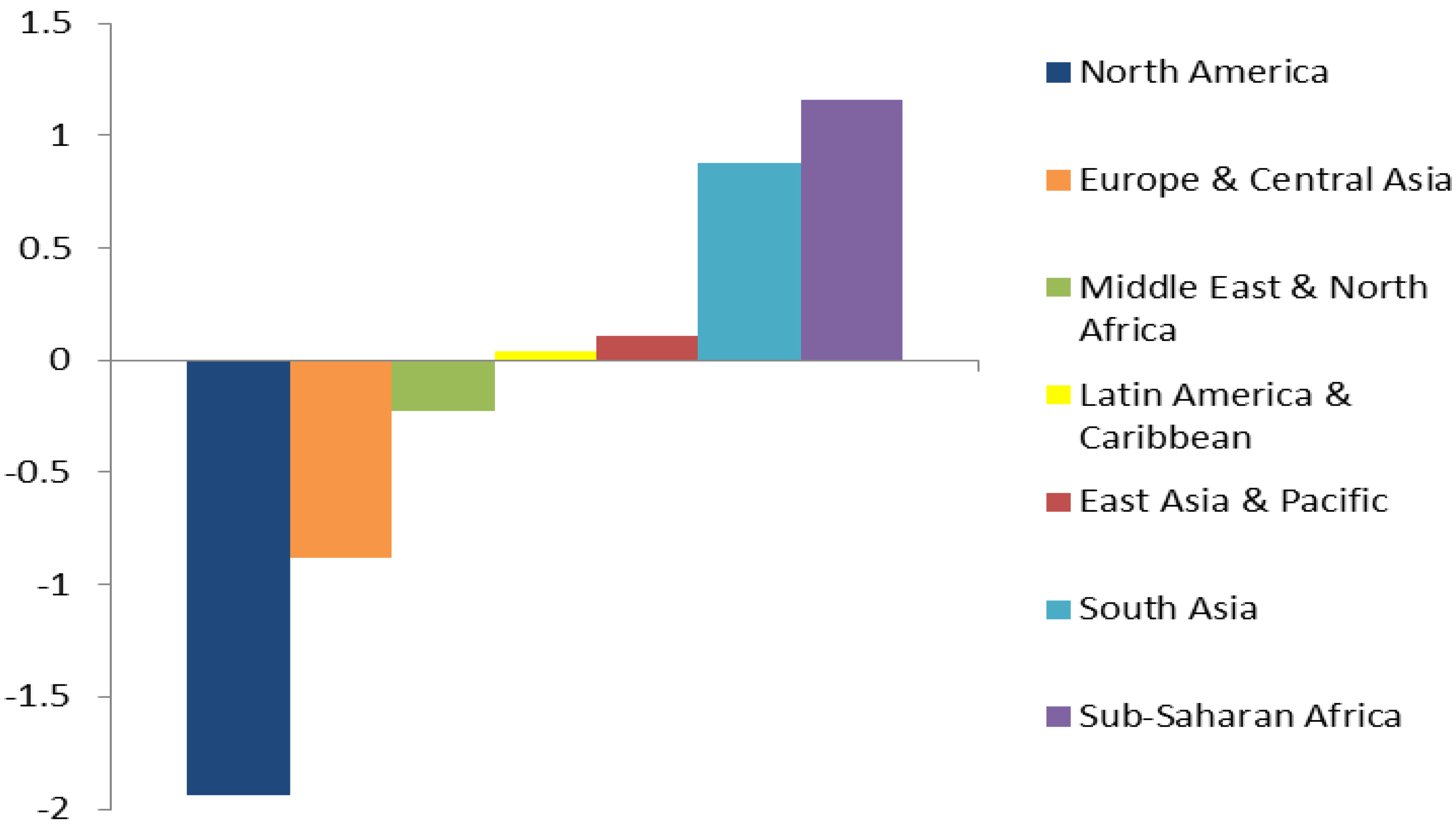
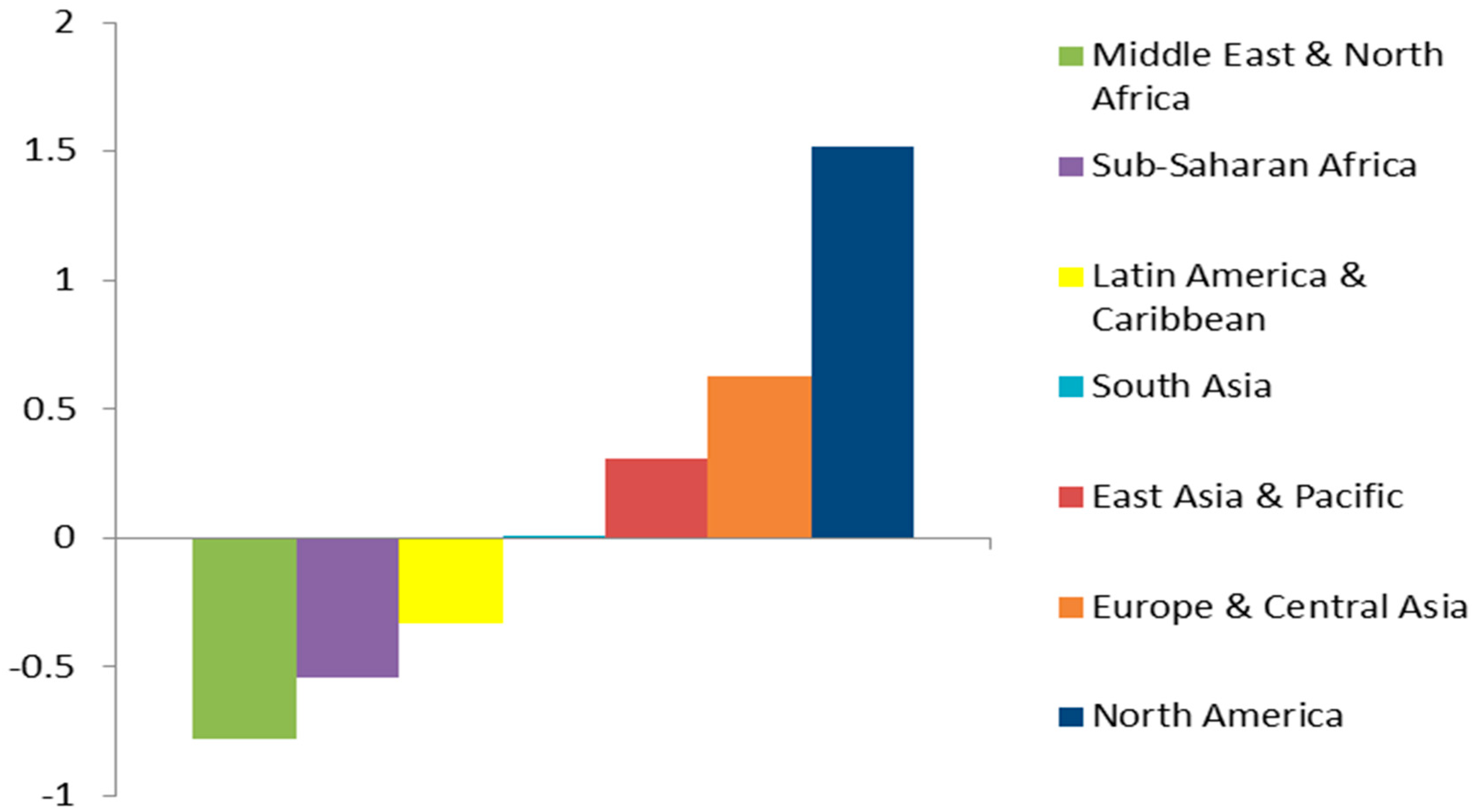
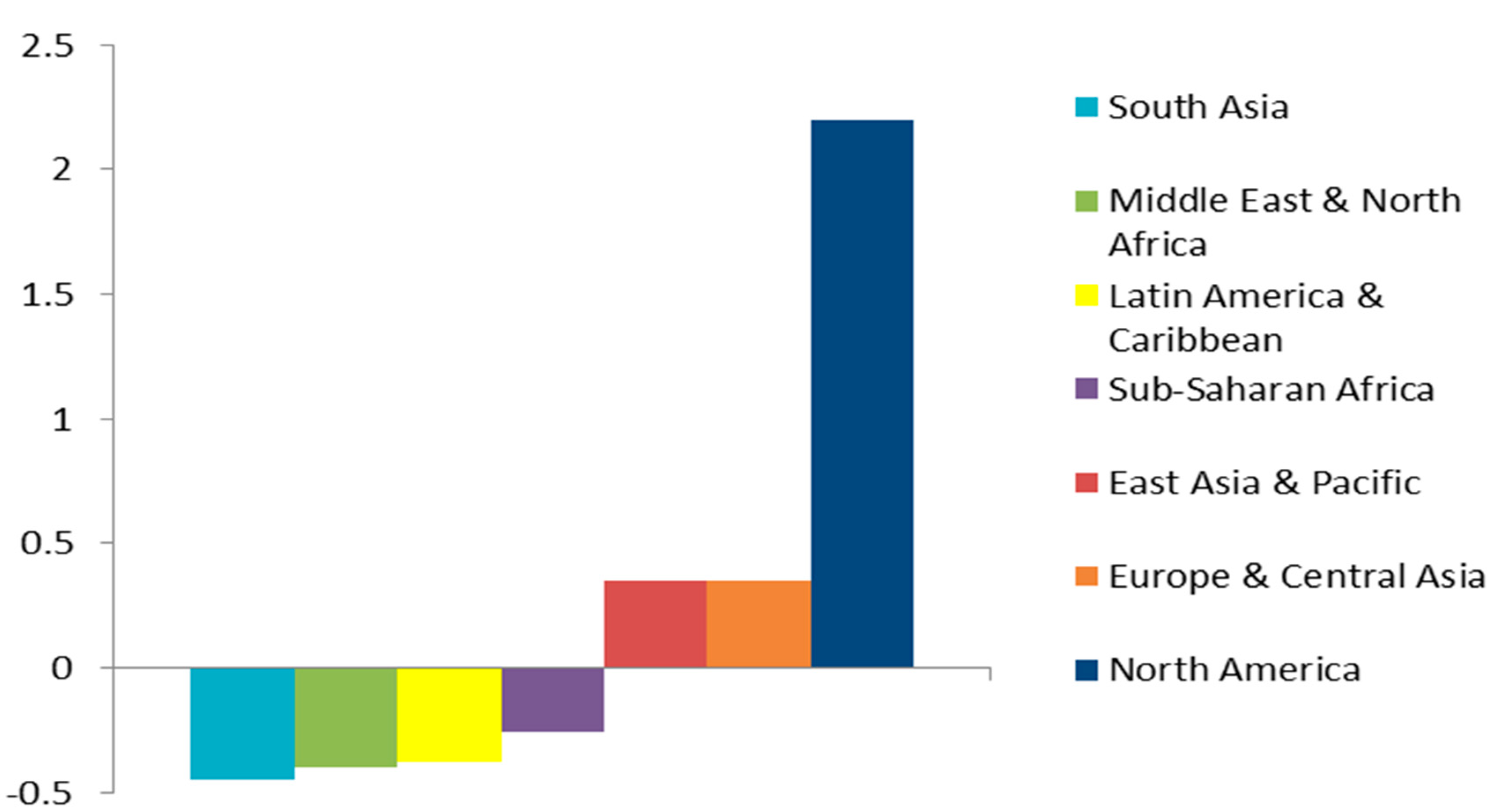
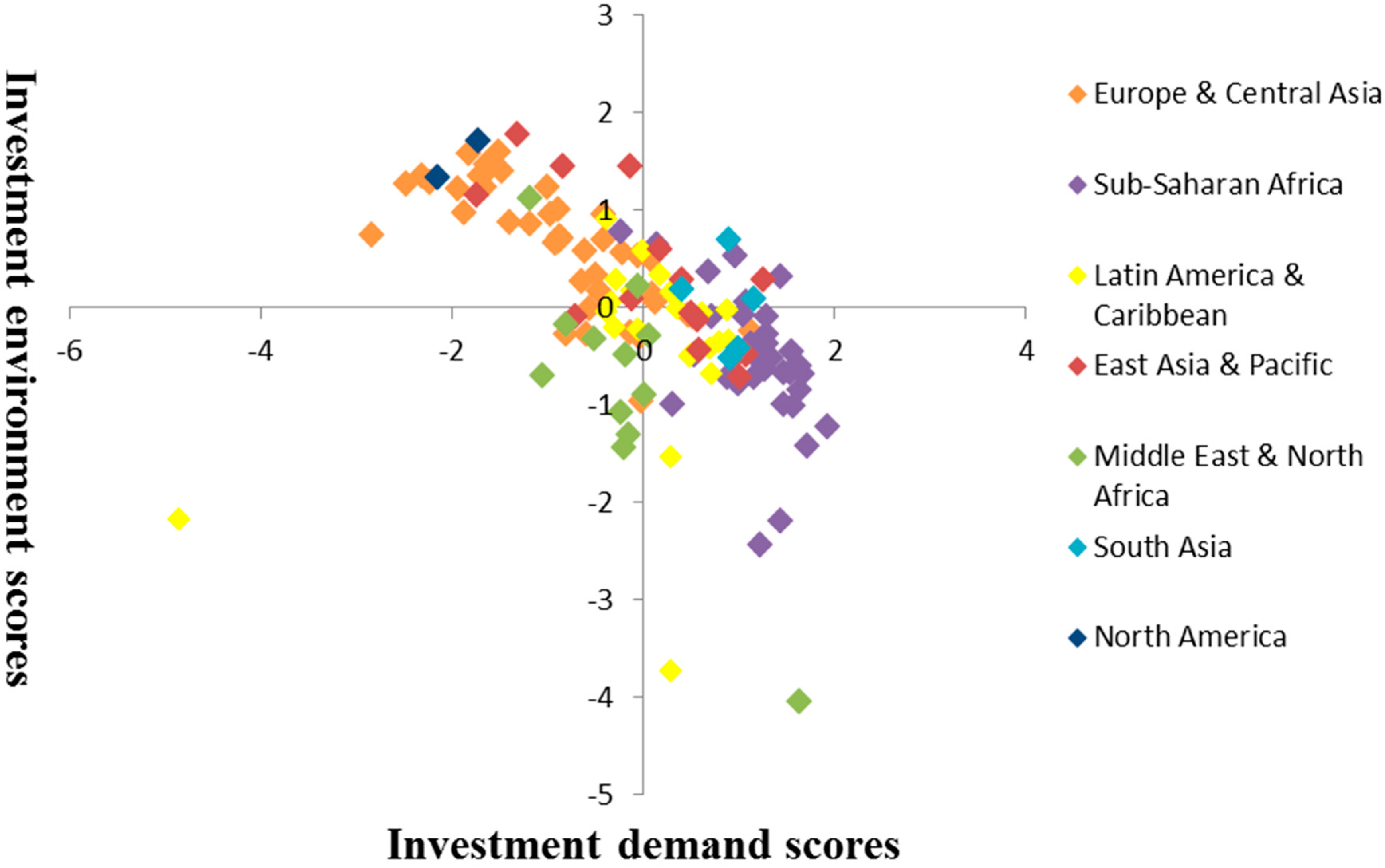
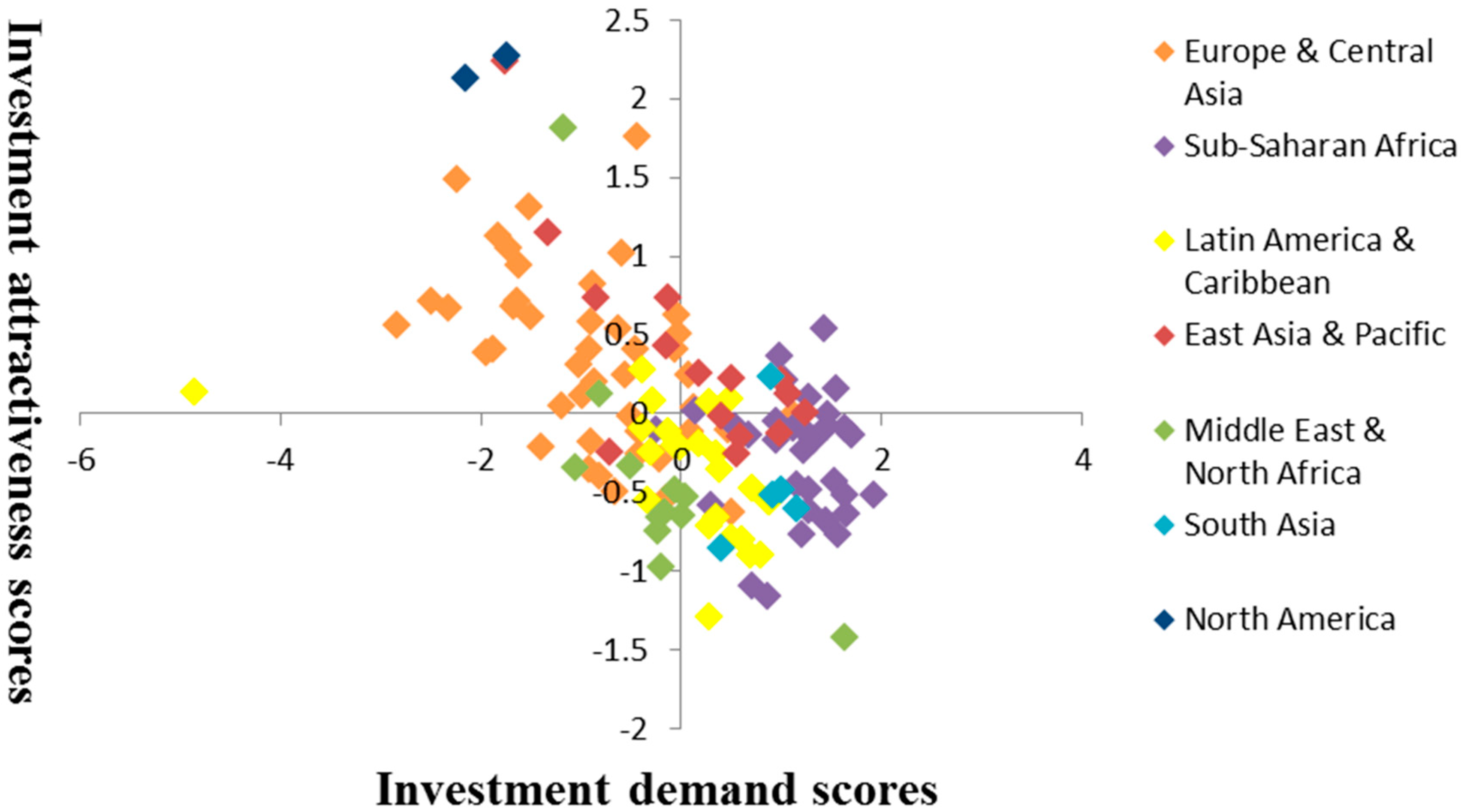
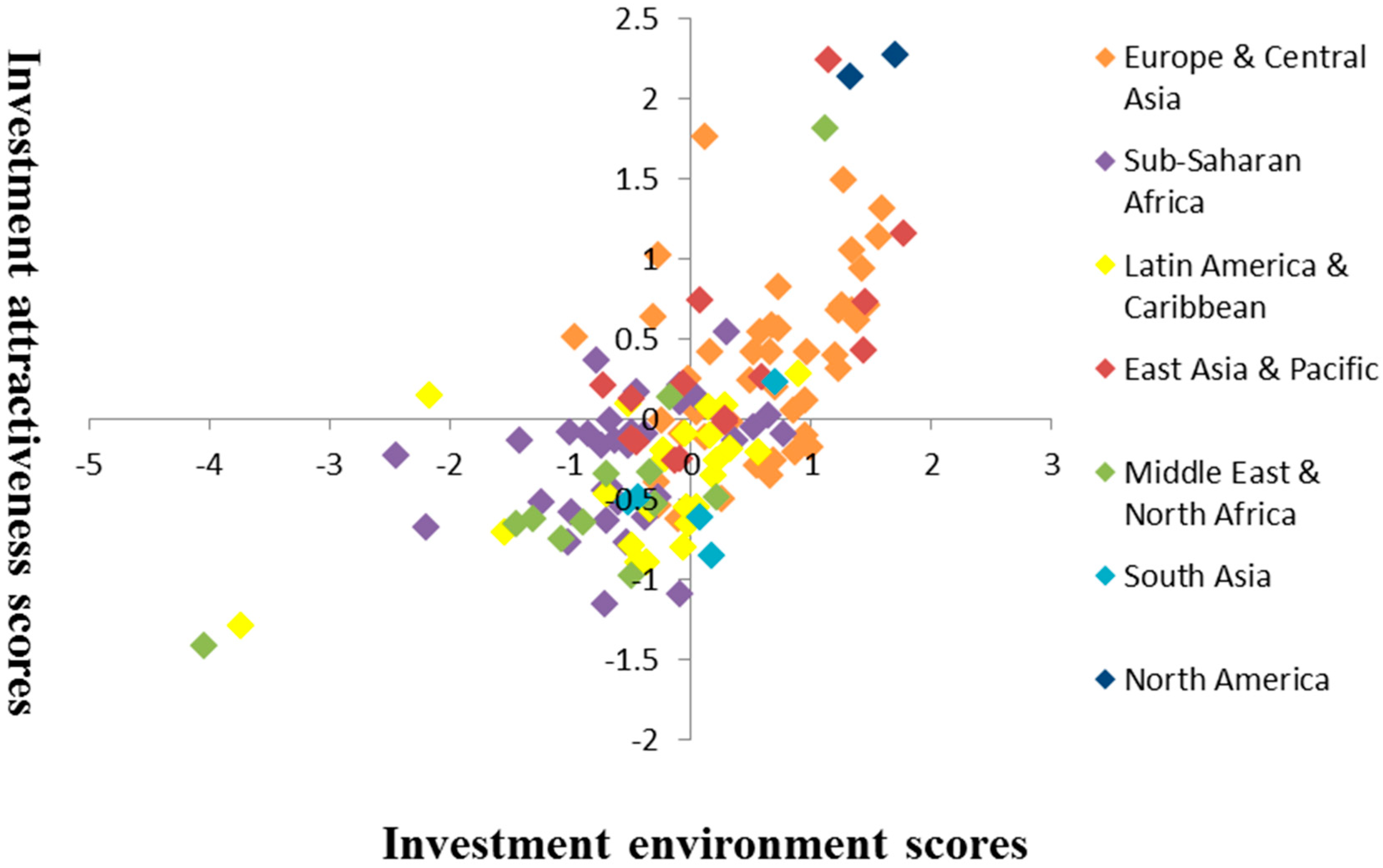
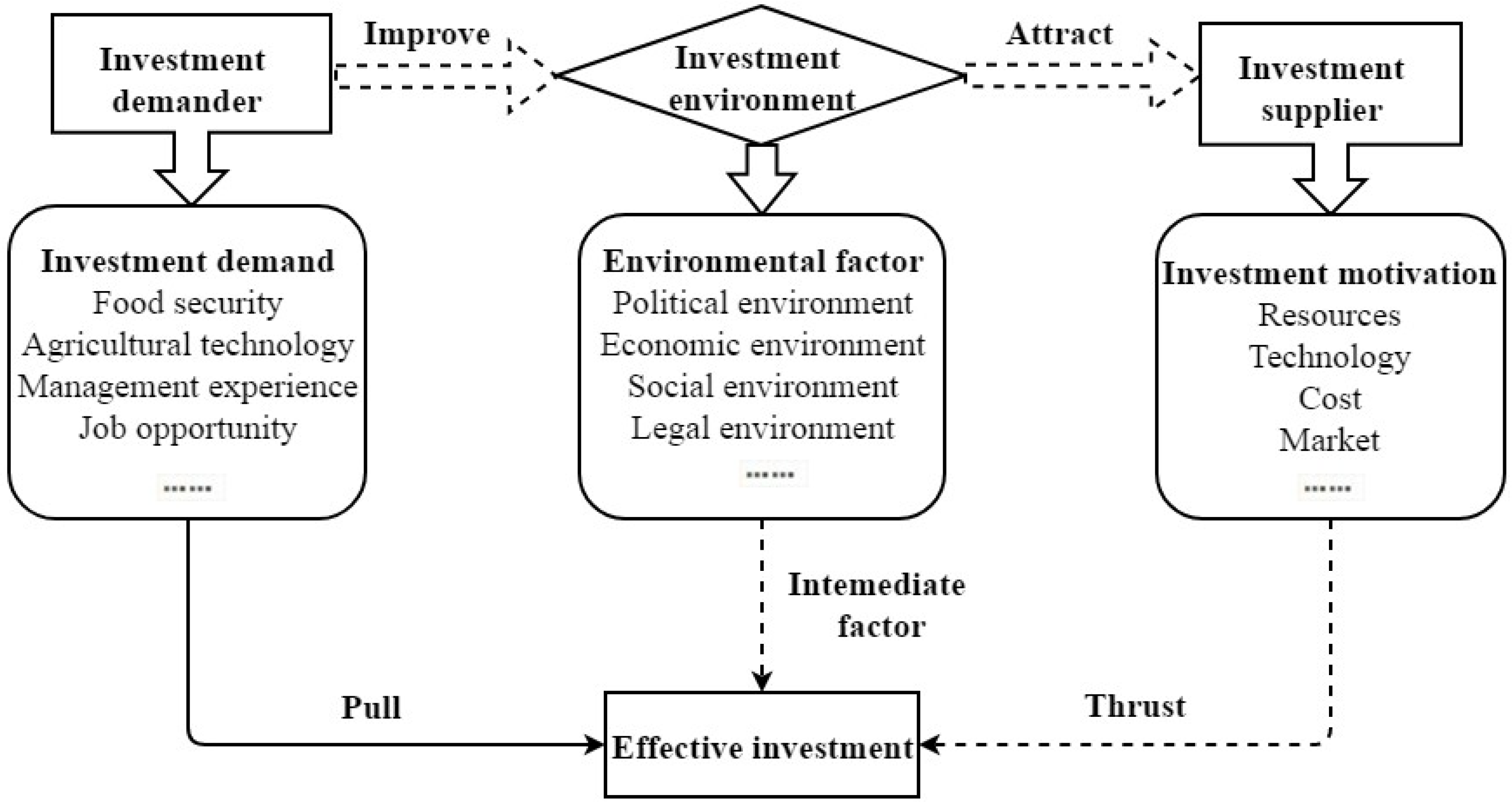
| Theories | Presenter | The Main Points | Location Selection |
|---|---|---|---|
| Monopolistic Advantage Theory [30] | Hymer (1960) | Monopolistic advantage is the driving force for international direct investment. | Multinational companies choose the host country’s location based on competitiveness. |
| Oligopolistic Reaction Theory [31] | Knicherbocker (1973) | Oligopolistic companies will take any action and other companies will respond. | International direct investment is more likely to flow to markets with different investment environments and countries with developed capital markets and oligopolistic market structures. |
| International Product Life Cycle Theory [32] | Vernon (1966) | It divides the product life cycle into a new product stage, a maturity stage, and a standardization stage. The latter two stages are suitable for FDI due to the gradual loss of monopolistic advantages. | The source of international direct investment is generally developed countries, and then investment in other developed countries with similar conditions but certain geographical advantages, and then turn to the developing countries. |
| Comprehensive Advantage Theory [33] | Kojima (1978) | FDI should be judged based on the principle of comparative cost. | FDI should be carried out in turn from industries in which the country is already at or about to be in a disadvantaged position. |
| Internalization Theory [34,35] | Buckley (1976) and Rugman (1987) | Intermediate products such as technology, knowledge, and management skills are flawed, and enterprises have the driving force to internalize the external market. | International direct investment flows to countries with incomplete markets. |
| Eclectic Theory of International Production [36] | Dunning (1977) | Companies can engage in FDI only when they have ownership advantages, internalization advantages and location advantages. | Companies are more likely to look for locations that can make full use of intellectual capital to strengthen or complement their core competencies. |
| Theory of Small-scale Technology [37] | Louis (1983) | The advantages of FDI in developing countries are small-scale manufacturing, local procurement and special products, and close to the market. | Multinational companies in developing countries are suitable to invest in low-income, small-market countries. |
| Theory of Technological Competence [38] | Cantwell (1989) | In the process of FDI, developing countries have gradually accumulated and improved their technological capabilities, and the investment field has gradually expanded from traditional industries to high-tech industries. | FDI follows the sequence from the surrounding areas to the developing countries to the developed countries. |
| Levels | Variables | Indicators | Data Sources | Year of Data |
|---|---|---|---|---|
| Host country’s investment demand | Food supply | Food Supply-Crops Primary Equivalent | FAO | 2013 |
| Agricultural productivity | Agriculture value added per worker | World Bank | 2018 | |
| Per capita capital stock | GDP per capita | World Bank | 2018 | |
| Economic and social development level | Human Development Index | UNDP Human Development Report | 2018 | |
| Corporate investment motivation | Agricultural resources | Arable land (hectares per person) | World Bank | 2016 |
| Market | Market size | The Global Competitiveness Report | 2018 | |
| Effectiveness | Labor market efficiency | The Global Competitiveness Report | 2018 | |
| Technology | Cereal yield (kg per hectare) | FAO | 2018 | |
| Host country’s investment environment | Economic stability | Inflation, GDP deflator | World Bank | 2018 |
| Political and legal environment | The Worldwide Governance Indicators | World Bank | 2018 | |
| Institutional condition | Investor protection | The Global Competitiveness Report | 2018 | |
| Infrastructure | Transport infrastructure | The Global Competitiveness Report | 2018 |
| Rankings | Countries | Scores | Rankings | Countries | Scores |
|---|---|---|---|---|---|
| 1 | Chad | 1.92 | 11 | Malawi | 1.46 |
| 2 | Ethiopia | 1.71 | 12 | Zimbabwe | 1.44 |
| 3 | Liberia | 1.66 | 13 | Rwanda | 1.43 |
| 4 | Madagascar | 1.64 | 14 | Guinea | 1.33 |
| 5 | Mozambique | 1.64 | 15 | Burkina Faso | 1.28 |
| 6 | Yemen | 1.64 | 16 | Senegal | 1.28 |
| 7 | Sierra Leone | 1.56 | 17 | Swaziland | 1.28 |
| 8 | Uganda | 1.55 | 18 | Gambia | 1.27 |
| 9 | Zambia | 1.53 | 19 | Timor-Leste | 1.25 |
| 10 | Tanzania | 1.47 | 20 | Congo | 1.23 |
| Rankings | Countries | Scores | Rankings | Countries | Scores |
|---|---|---|---|---|---|
| 1 | New Zealand | 1.78 | 11 | Ireland | 1.34 |
| 2 | Canada | 1.7 | 12 | United States of America | 1.33 |
| 3 | United Kingdom | 1.6 | 13 | Switzerland | 1.28 |
| 4 | Denmark | 1.57 | 14 | Norway | 1.26 |
| 5 | Sweden | 1.47 | 15 | Spain | 1.23 |
| 6 | Japan | 1.45 | 16 | Finland | 1.23 |
| 7 | Malaysia | 1.44 | 17 | Austria | 1.21 |
| 8 | Netherlands | 1.42 | 18 | Australia | 1.15 |
| 9 | France | 1.39 | 19 | United Arab Emirates | 1.12 |
| 10 | Germany | 1.34 | 20 | Slovenia | 1 |
| Rankings | Countries | Scores | Rankings | Countries | Scores |
|---|---|---|---|---|---|
| 1 | Yemen | −4.04 | 11 | Algeria | −1.07 |
| 2 | Venezuela | −3.73 | 12 | Sierra Leone | −1.02 |
| 3 | Congo | −2.44 | 13 | Malawi | −1 |
| 4 | Zimbabwe | −2.19 | 14 | Gabon | −0.99 |
| 5 | Argentina | −2.17 | 15 | Ukraine | −0.96 |
| 6 | Suriname | −1.54 | 16 | Lebanon | −0.89 |
| 7 | Egypt | −1.44 | 17 | Madagascar | −0.85 |
| 8 | Ethiopia | −1.42 | 18 | Nigeria | −0.78 |
| 9 | Iran | −1.3 | 19 | Cameroon | −0.73 |
| 10 | Chad | −1.23 | 20 | Laos | −0.72 |
| Rankings | Countries | Scores | Rankings | Countries | Scores |
|---|---|---|---|---|---|
| 1 | Canada | 2.27 | 11 | Russian Federation | 1.02 |
| 2 | Australia | 2.24 | 12 | Netherlands | 0.94 |
| 3 | United States of America | 2.13 | 13 | Estonia | 0.82 |
| 4 | United Arab Emirates | 1.81 | 14 | China | 0.74 |
| 5 | Kazakhstan | 1.76 | 15 | Japan | 0.73 |
| 6 | Switzerland | 1.49 | 16 | Norway | 0.71 |
| 7 | United Kingdom | 1.31 | 17 | Sweden | 0.71 |
| 8 | New Zealand | 1.15 | 18 | Finland | 0.68 |
| 9 | Denmark | 1.13 | 19 | Ireland | 0.67 |
| 10 | Germany | 1.05 | 20 | Azerbaijan | 0.63 |
| Rankings | Countries | Scores | Rankings | Countries | Scores |
|---|---|---|---|---|---|
| 1 | Yemen | −1.42 | 11 | Sierra Leone | −0.77 |
| 2 | Venezuela | −1.29 | 12 | Lesotho | −0.77 |
| 3 | Mauritania | −1.16 | 13 | Algeria | −0.75 |
| 4 | Cape Verde | −1.09 | 14 | Suriname | −0.71 |
| 5 | Tunisia | −0.98 | 15 | Zimbabwe | −0.68 |
| 6 | El Salvador | −0.9 | 16 | Egypt | −0.66 |
| 7 | Honduras | −0.9 | 17 | Dominican Republic | −0.66 |
| 8 | Sri Lanka | −0.85 | 18 | Lebanon | −0.65 |
| 9 | Ecuador | −0.8 | 19 | Liberia | −0.64 |
| 10 | Guyana | −0.79 | 20 | Iran | −0.63 |
© 2020 by the authors. Licensee MDPI, Basel, Switzerland. This article is an open access article distributed under the terms and conditions of the Creative Commons Attribution (CC BY) license (http://creativecommons.org/licenses/by/4.0/).
Share and Cite
Jiang, X.; Chen, Y. The Potential of Absorbing Foreign Agricultural Investment to Improve Food Security in Developing Countries. Sustainability 2020, 12, 2481. https://doi.org/10.3390/su12062481
Jiang X, Chen Y. The Potential of Absorbing Foreign Agricultural Investment to Improve Food Security in Developing Countries. Sustainability. 2020; 12(6):2481. https://doi.org/10.3390/su12062481
Chicago/Turabian StyleJiang, Xiaoyu, and Yangfen Chen. 2020. "The Potential of Absorbing Foreign Agricultural Investment to Improve Food Security in Developing Countries" Sustainability 12, no. 6: 2481. https://doi.org/10.3390/su12062481
APA StyleJiang, X., & Chen, Y. (2020). The Potential of Absorbing Foreign Agricultural Investment to Improve Food Security in Developing Countries. Sustainability, 12(6), 2481. https://doi.org/10.3390/su12062481




